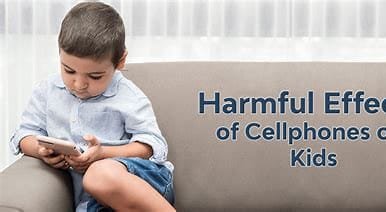Smartphones have become ubiquitous in every physical space in daily life in this digital century. It is definitely true that they attract children. In trying to decide whether or not to give a smartphone to a child, parents consider the gift of accessibility to educational apps, social interaction, and amusement. However, the disadvantages associated with giving smartphones to children, especially when they are still young, are considerable and deserve analysis from perspectives such as health, social, educational, and developmental considerations.

1. Health Risks
The other major concern with children using a smartphone is the health risk of excessive screen time. One after another, many health issues related to screen time have been reported. For example, bad eyesight, sleeping disorder, and other sedentary behavior problems.
Physical Health: The overuse of smartphones can lead to eye strain. This condition is also called “digital eye strain” or “computer vision syndrome.” A few people who are over users of smartphones complain of dry eyes, blurred vision, headaches, and neck or shoulder pain. There has been an understanding that young children are susceptible to the physical strain brought about by long hours of screen use because their bodies are still developing. Additionally, the radiation emitted in blue light from the screens of mobile phones tends to interfere with the production of melatonin, which regulates sleep, thus resulting in poor sleeping patterns.
There is now growing evidence that there is a link between smartphone use and poor mental health outcomes among children who are already anxious, depressed, or simply feeling lonely. Social media is specifically feeding comparison, bullying, and unrealistic expectations in children and young teens that generate unnecessary stress trying to present a “perfect” life on social media, thereby reducing self-esteem and leading to poor mental health outcomes.
2. Social isolation and behavioral issues
Meant to increase connectivity, smartphones end up isolating children even when they have learned neither how to establish relationships nor face-to-face contacts in school. All day attached to their screens, the opportunities to have meaningful, in-person communication that forms the ground for developing social skills are missed.
Social Isolation: Researchers have proved that kids who spend too much time on their smartphones are generally unable to develop effective social skills. They do not participate in playground activities, nor can they engage in face-to-face conversations with friends; instead, they would like to send texts or follow social media sites. This limited social interaction can lead to the absence of sympathetic feelings and poor communication, which are crucial elements for a well-functioning relationship.
Behavioral Problems. The quicker gratification of mobiles also brings problems. Thousands of applications and games on their mobile phones help children grow depending on stimuli and quick rewards so that they have short attention spans, are impatient, and cannot control their impulses. For instance, children who are made to watch fast games regularly will soon lose the ability to pay attention and tend to become disoriented and unable to stay in line with a slower but more cognitively demanding task such as reading or studying.
3. Learning Problems

Whereas smartphones may offer educational content, they also may pose major distractions for kids. A child who can enjoy smartphones throughout the day usually lacks the concentration needed for schoolwork or other educational activities due to constant notifications from apps, social media, or games.
Distracting from studies: The presence of a smartphone can disturb a child’s academic life a lot. For example, at the time of homework or classes, the desire to read some notifications or play a rapid game may pull the attention and learning away. Some research indicates that the ability of the processing capacity to store information in the brain reduces with the help of a smartphone. This is likely to make it difficult for the children to fare well at school.
Low literacy and critical thinking: Besides, smartphones often cultivate skimming through social media feeds, memes, or short articles. This is not deep reading. Deep reading is fundamental in the development of literacy, understanding, and critical thinking. Children who spend more time scrolling through apps miss the benefit of engaging deeply with longer texts or solving more complex problems.
4. Addiction and Overdependence
Another worrying trend about giving smartphones to children is that of addiction. It has proven relatively easy for children to enter unhealthy relationships with technology because they are often not mature enough in terms of self-regulation skills to place necessary boundaries in their lives.
Technology Addiction As studies indicate, your smartphone can activate the same dopamine rush as gambling or certain substances. This will create a cycle of dependence in which kids feel they must constantly check their phone for new notifications, likes, or messages. It can easily evolve into a full-blown addiction, with kids feeling withdrawal symptoms whenever they are separated from their devices.
The Loss of Time Spent in Creative or Physical Play Another thing the smartphone deprives a child of is the time that would otherwise have been used in creative or physical play, both of which play important roles in healthy growth. Instead of imaginative games and outdoor activities or various hobbies, children become fixated on digital entertainment, which depresses creativity, lessens the opportunity for physical exercise, and undermines proper emotional development.
5. From a Parental and Societal View
Parents are once again divided by the issue of whether smartphones should be allowed to children. Then there is one side that states it provides easy, safe, and educational convenience, while the opposite side sees parents becoming even more alert of potential dangers.
Parental monitoring vs. autonomy:
Again, many parents give their children smartphones so they can communicate with the family and stay safe. However, when relying on smartphones for security, there also lies a danger to children in online crimes such as bullying, inappropriate content, and even pedophiles. That is a balance between letting them go and monitoring their activity.
Cultural and social pressures: society also contributes to the same. They feel that they need to keep abreast of the leading peers, most of whom today have a smartphone at a tender age. The parents then feel forced to give in to these pressures and whatnot, for fear their child would be left out from social circles or deprived of technological advancements.
Conclusion

Of course, there are positive sides to having a smartphone, like educational apps, easy communication, and safety. What may appear to be relatively serious disadvantages of smartphones, especially regarding a child, are health complications, social isolation, academic problems, and addiction. As such, regarding the potential risks in child development, parents should not take these lightly and take measures that could bar smartphone use in the life of a child. A balanced approach, where the use of smartphones is responsible and in moderation, could help shield children from such hazards.



